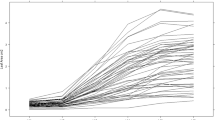Abstract
Significant differences in tuber glycoalkaloid (TGA) content were found among parents and among family means in a two year study of 10 tetraploid crosses. TGA contents of the parents ranged from 3.6–36 mg/100 g, with an average content of 10 mg/100 g.
Offspring variations within families were generally continuous, indicating polygenic inheritance. Heritability (1-year—1-replicate base) ranged from 86–89% in the broad sense and from 66–84% in the narrow sense. It was concluded that TGA content is highly heritable.
The use of parents with high TGA contents in a breeding program is discussed.
Similar content being viewed by others
Literature Cited
Baerug, Ragnar. 1962. Influence of different rates and intensities of light on solanine content and cooking quality of potato tubers. Eur. Potato J. 5: 242–251.
Baker, L. C., L. H. Lampitt and O. B. Meredith. 1955. Solanine glycoside of the potato. III. An improved method of extraction and determination. J. Sci. Food Agr. 6: 197–202.
Dahlman, D. L. and E. T. Hibbs. 1967. Response ofEmpoasca fabae (Cicadellidae: Homoptera) to tomatine, solanine, leptine I, tomatidine, solanidine, and demissidine. Annals Entomol. Soc. Am. 60: 732–740.
Fontaine, T. D., G. W. Irving, Jr., R. M. Ma, J. B. Poole and S. P. Doolittle. 1948. Isolation and partial characterization of crystalline tomatine, an antibiotic agent from the tomato plant. Arch. Biochem. 18: 467–475.
Fraenkel, G. S. 1959. The raison d’etre of secondary plant substances. These odd chemicals arose as a means of protecting plants from insects and now guide insects to food. Science 129: 1466–1470.
Georgieva, R. and B. Rondov. 1954. [Investigating the inheritance of the solanine type of glycoalkaloids in some interspecific hybrids of the potato]. Izv. Int. Rastenievadstvo 225–240. Plant Breed. Abstr. 25: 3191.
Kempthorne, O. 1955. The correlation between relatives in a simple autotetraploid population. Genetics 40: 168–174.
Kuhn, R. and I. Low. 1955. Resistance factors againstLeptinotarsa decemlineata (Say) isolated from the leaves of wildSolanum species. Page 122–132.In M. G. Sevag, R. D. Reid and O. E. Reynolds (ed.). Origins of Resistance to Toxic Agents, Academic Press Inc., New York.
Prokoshev, S. M., E. I. Petrochenko and V. Z. Baranova. 1952. [Glucoalkaloids of tuber-bearing forms ofSolanum in connection with their resistance to Colorado beetle]. Doklady Akad. Nauk (USSR) 82: 955–958.
Prokoshev, S. M., E. I. Petrochenko and V. Z. Baranova. 1952. [Inheritance of glycoalkaloids by intraspecific hybrids of the potato]. Doklady Acad. Nauk (USSR) 83: 457–460. Chem. Abstr. 46: 8722.
Ross, H. 1966. The use of wildSolanum species in German potato breeding of the past and today. Amer. Potato J. 43: 63–80.
Sanford, L. L., T. J. Fitzpatrick and W. L. Porter. 1971. Selection potential for tuber total nitrogen and total solids in a tetraploid breeding population. Amer. Potato J. 48: 428–437.
Schreiber, K. 1957. Naturally occurring plant resistance factors against the Colorado potato beetle (Leptinotarsa decemlineata) and their possible mode of action. Zuchter 27: 289–299.
Schwarze, P. 1962. [Methods for identification and determination of solanine in potato breeding material]. Zuchter 32: 155–160.
Schwarze, P. 1963. [The glycoalkaloid content and the composition of the glycoalkaloid complex in progenies of the interspecific crossS. tuberosum xS. chacoense]. Zuchter 33: 275–281.
Sturckow, B. and I. Low. 1961. [The effects of someSolanum alkaloid glycosides on the potato beetle]. Entomol. Exptl. Appl. 4: 133–142. Chem. Abstr. 56: 5156.
Wierzchowski, P and Z. Wierzchowska. 1961. Colorimetric determination of solanine and solanadine with antimony trichloride. Chem. Anal. (Warsaw) 6: 579–585. Chem. Abstr. 56: 5052.
Wolf, M. J. and B. M. Duggar. 1946. Estimation and physiological role of solanine in the potato. J. Agric. Res. 53: 1–32.
Author information
Authors and Affiliations
Rights and permissions
About this article
Cite this article
Sanford, L.L., Sinden, S.L. Inheritance of potato glycoalkaloids. American Potato Journal 49, 209–217 (1972). https://doi.org/10.1007/BF02864830
Accepted:
Issue Date:
DOI: https://doi.org/10.1007/BF02864830



